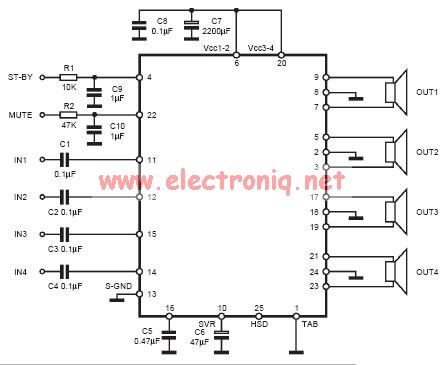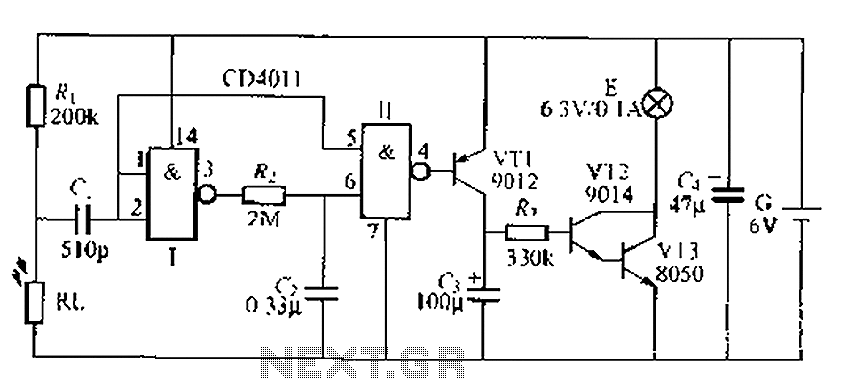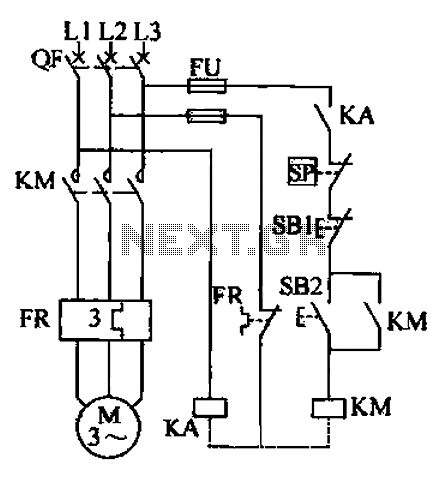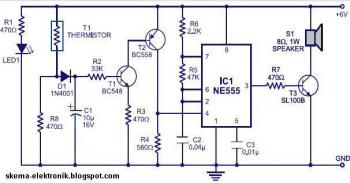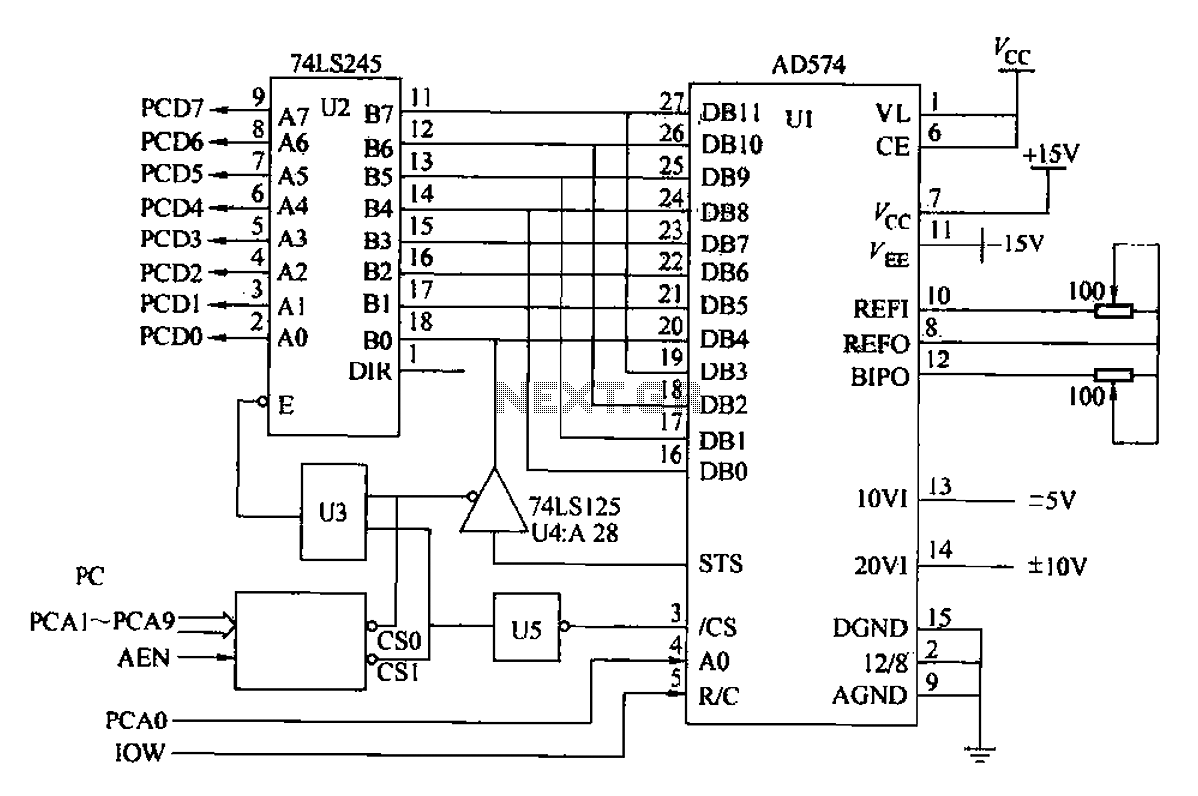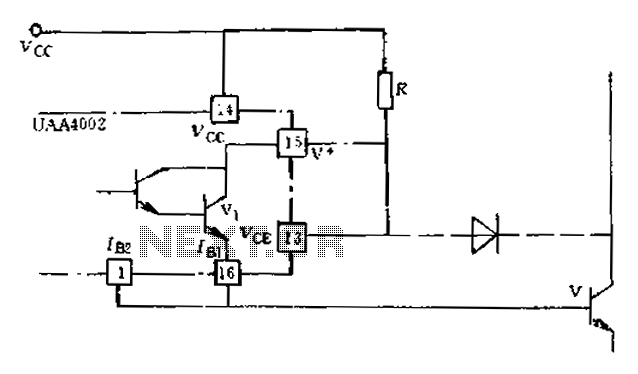
Automatic Turn-Off Control For Automobiles Circuit
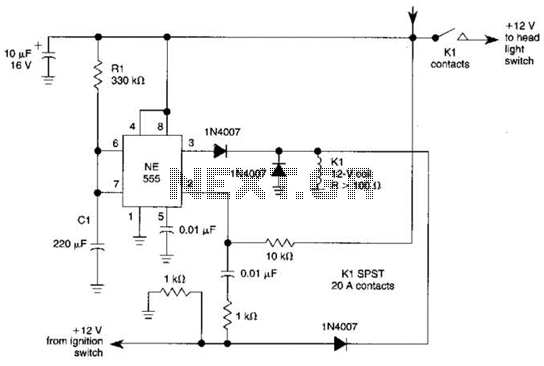
When the ignition switch is activated, relay K1 receives continuous power, allowing the headlights to be turned on. When the ignition is turned off, timer IC1 is activated, maintaining its power for a duration determined by resistor R1 and capacitor C1. With the specified component values, this configuration results in an approximate delay of one minute. The values of R1 and C1 can be adjusted to modify this delay time.
The circuit operates by integrating a relay and a timer IC to control the headlights in relation to the ignition status of the vehicle. Upon turning the ignition switch to the "on" position, relay K1 is energized, facilitating the flow of current to the headlights. This allows the driver to utilize the headlights while the vehicle is running.
Once the ignition switch is turned off, timer IC1 is triggered, initiating a timing cycle that keeps the headlights illuminated for a predetermined duration. The timing interval is governed by the RC time constant, which is calculated based on the values of resistor R1 and capacitor C1. The relationship can be expressed with the formula T = R1 * C1, where T is the time delay in seconds. By selecting different resistor and capacitor values, the delay can be tailored to meet specific requirements, accommodating various user preferences or vehicle specifications.
For example, if R1 is set to 100 kΩ and C1 to 100 µF, the resulting delay time would be approximately 10 seconds. Conversely, increasing R1 to 220 kΩ or using a larger capacitor will extend the delay time, while decreasing these values will shorten it. This flexibility allows for customization of the circuit's performance based on the desired operational characteristics.
The relay K1 serves as a critical component for controlling the power to the headlights, ensuring they remain operational for the specified delay period after the ignition is switched off. This feature enhances vehicle safety by preventing the driver from inadvertently leaving the headlights on, which could lead to battery drain. Overall, this circuit design effectively combines a relay and a timer IC to provide a practical solution for headlight control in automotive applications. When the ignition switch is on, relay K1 is energized continuously, and the headlights can be turned on. Turning off the ignition turns on timer IC1,which keeps IC1 energized for a time determined by Rl and CI.
With the values shown approximately a 1 minute delay will result. The values of Rl or CI can be changed to vary this delay time. 🔗 External reference
The circuit operates by integrating a relay and a timer IC to control the headlights in relation to the ignition status of the vehicle. Upon turning the ignition switch to the "on" position, relay K1 is energized, facilitating the flow of current to the headlights. This allows the driver to utilize the headlights while the vehicle is running.
Once the ignition switch is turned off, timer IC1 is triggered, initiating a timing cycle that keeps the headlights illuminated for a predetermined duration. The timing interval is governed by the RC time constant, which is calculated based on the values of resistor R1 and capacitor C1. The relationship can be expressed with the formula T = R1 * C1, where T is the time delay in seconds. By selecting different resistor and capacitor values, the delay can be tailored to meet specific requirements, accommodating various user preferences or vehicle specifications.
For example, if R1 is set to 100 kΩ and C1 to 100 µF, the resulting delay time would be approximately 10 seconds. Conversely, increasing R1 to 220 kΩ or using a larger capacitor will extend the delay time, while decreasing these values will shorten it. This flexibility allows for customization of the circuit's performance based on the desired operational characteristics.
The relay K1 serves as a critical component for controlling the power to the headlights, ensuring they remain operational for the specified delay period after the ignition is switched off. This feature enhances vehicle safety by preventing the driver from inadvertently leaving the headlights on, which could lead to battery drain. Overall, this circuit design effectively combines a relay and a timer IC to provide a practical solution for headlight control in automotive applications. When the ignition switch is on, relay K1 is energized continuously, and the headlights can be turned on. Turning off the ignition turns on timer IC1,which keeps IC1 energized for a time determined by Rl and CI.
With the values shown approximately a 1 minute delay will result. The values of Rl or CI can be changed to vary this delay time. 🔗 External reference
